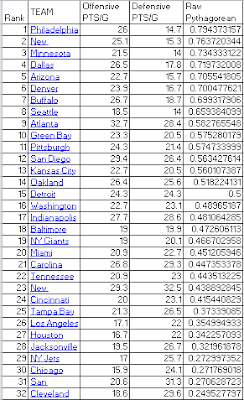Earlier this week (prior to the start of the World Series) I posted the Grid O' Sadness, showing the relative odds of the Cubs, Bears, Indians, and Browns winning the most of their remaining games. Since then, the Indians have won two games, the Cubs one, and my promise to explain my methodology struggled to happen. Since Purdue is currently struggling against Penn State, I decided to get my mind off those struggles by explaining the methodology.
First though, an update to the Grid O' Sadness (again, I apologize):
First though, an update to the Grid O' Sadness (again, I apologize):
So, that's looking up for the Indians.
The model I created to simulate the remainder of the season is based on two statistical tools: the Pythagorean expectation (1), which I used in my discussion of the NFL preseason, and log5 (2). Both were developed by Bill James to analyze teams in baseball. The Pythagorean expectation uses the points (I'm saying points instead of runs to use the same term across multiple sports) scored and points allowed by a team to create an expectation of the winning percentage of a team. This tends to be more accurate at rating teams than the real winning percentage. For the MLB teams, I used their regular season statistics (3); since on average the average MLB team is average, it gives a more equivalent comparison than including postseason statistics that are dependent on the teams faced in the postseason (which vary in ability significantly) For the NFL teams, I used their statistics (4) so far on a per-game basis (since NFL teams have played differing numbers of game); since we are about halfway through the season, the average team they have faced can be assumed to be average.
Ok, having rated the two World Series teams and the entire NFL (I am pretty meh to say my Washington Redskins are at 16th), I can use those the Pythagorean expectations to calculate game odds using Log5, which takes the winning percentage of two teams to create the probability a team will win. Using the probabilities, the World Series and remaining NFL schedules (5, 6) of the teams of Cleveland and Chicago can be simulated (100000 times), producing win totals (and the probabilities of them) and the resulting Grid O' Sadness.
Also, since as a result I had to produce rankings for the entire NFL (as of Wednesday), those are added to this post as well. Chicago, you can take away your Bears aren't the worst team in the NFL. Both the 49er and Browns are worse teams than you. For Cleveland fans... well, at least you had the NBA title and maybe the World Series. And maybe your college football team of choice can not continuously turnover the ball. Boilers.
Citations
(1) https://en.wikipedia.org/wiki/Pythagorean_expectation
(2) https://en.wikipedia.org/wiki/Log5
(3) http://www.espn.com/mlb/standings/_/group/league
(4) http://www.espn.com/nfl/statistics/team/_/stat/total; http://www.espn.com/nfl/statistics/team/_/stat/total/position/defense
(5) http://www.clevelandbrowns.com/schedule-and-events/schedule.html
(6) http://www.chicagobears.com/gameday/schedule.html


Comments
Post a Comment